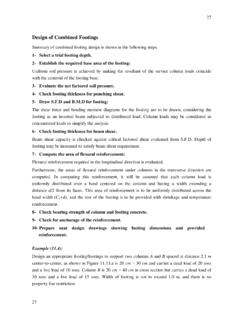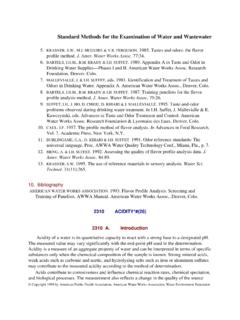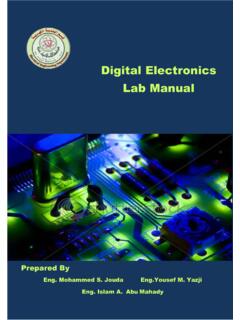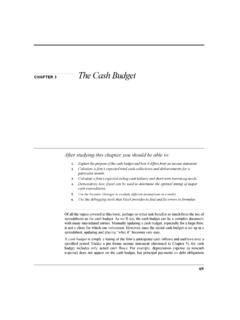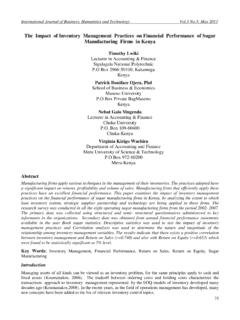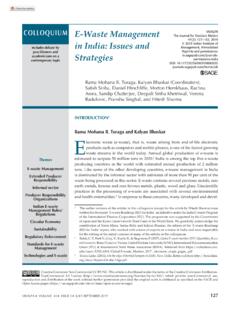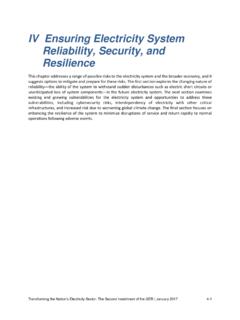Transcription of Principles of Information Systems , 10th ed.
1 Licensed to: Principles of Information Systems ,Tenth EditionRalph M. Stair & George W. ReynoldsExecutive Vice President and Publisher:Jonathan HulbertExecutive Vice President of Editorial, Business:Jack W. CalhounPublisher: Joe SabatinoSr. Acquisitions Editor: Charles McCormick, Product Manager: Kate MasonSr. Content Project Manager: Jill BraiewaMarketing Manager: Adam MarshSr. Marketing Communications Manager:Libby ShippMarketing Coordinator: Suellen RuttkayEditorial Assistant: Nora HeinkMedia Editor: Chris ValentineSr. Art Director: Stacy Jenkins ShirleyPrint Buyer: Julio EsperasCover Designer: cmiller designCover Photos: Getty ImagesCompositor: Value ChainCopyeditor: Mary KemperProofreader: Green Pen Quality AssuranceIndexer: Alexandra Nickerson 2012 Course Technology, Cengage LearningALL RIGHTS RESERVED. No part of this work covered by the copyright herein may be reproduced, transmitted, storedor used in any form or by any means graphic, electronic, or mechanical, including but not limited to photocopying,recording, scanning, digitizing, taping, Web distribution, Information networks, or Information storage and retrievalsystems, except as permitted under Section 107 or 108 of the 1976 United States Copyright Act, without the priorwritten permission of the product Information and technology assistance, contact us atCengage Learning Customer & Sales Support, 1-800-354-9706 For permission to use material from this text or product, submit allrequests online at permissions questions can be emailed Edition:ISBN-13: 978-0-538-47829-8 ISBN-10: 0-538-47829-2 Instructor s Edition:ISBN-13: 978-1-111-53109-6 ISBN-10.
2 1-111-53109-9 Course Technology20 Channel Center StreetBoston, MA 02210 USASome of the product names and company names used in this book have been used for identification purposes onlyand may be trademarks or registered trademarks of their respective manufacturers and fictional data related to persons or companies or URLs used throughout this book is intended for instructionalpurposes only. At the time this book was printed, any such data was fictional and not belonging to any real personsor Technology, a part of Cengage Learning, reserves the right to revise this publication and make changes fromtime to time in its content without Learning is a leading provider of customized learning solutions with office locations around the globe, in-cluding Singapore, the United Kingdom, Australia, Mexico, Brazil and Japan. Locate your local office Learning products are represented in Canada by Nelson Education, learn more about Course Technology, visit any of our products at your local college store or at our preferred online store in the United States of America1 2 3 4 5 6 7 16 15 14 13 12 11 10 Copyright 2011 Cengage Learning.
3 All Rights Reserved. May not be copied, scanned, or duplicated, in whole or in part. Due to electronic rights, some third party content may be suppressed from the eBook and/or eChapter(s). Editorial review has deemed that any suppressed content does not materially affect the overall learning experience. Cengage Learning reserves the right to remove additional content at any time if subsequent rights restrictions require to:An Introduction toInformation SystemsLEARNING OBJECTIVESPRINCIPLESCHAPTER 1 nThe value of Information is directly linkedto how it helps decision makers achieve theorganization s why it is important to study and under-stand Information data from Information and describethe characteristics used to evaluate the qualityof and Information Systems helpmake it possible for organizations toimprove the way they conduct the components of an informationsystem and describe several the potential impact of informa-tion Systems and having the ability to putthis knowledge to work can result in asuccessful personal career and in organi-zations that reach their the components of a computer-basedinformation the basic types of business informationsystems and discuss who uses them, how theyare used, and what kinds of benefits users.
4 Business managers, andinformation Systems professionals mustwork together to build a successfulinformation the major steps of the Systems devel-opment process and state the goal of Systems must be appliedthoughtfully and carefully so that society,businesses, and industries can reap theirenormous some of the threats that informationsystems and the Internet can pose to securityand the expanding role and benefits of in-formation Systems in business and industry. Copyright 2011 Cengage Learning. All Rights Reserved. May not be copied, scanned, or duplicated, in whole or in part. Due to electronic rights, some third party content may be suppressed from the eBook and/or eChapter(s). Editorial review has deemed that any suppressed content does not materially affect the overall learning experience. Cengage Learning reserves the right to remove additional content at any time if subsequent rights restrictions require to: Information Systems in the Global EconomyBraskem , BrazilThe Power of Information in the Petrochemical IndustryYou ve probably heard that Information is power.
5 In fact, the power of informationdepends on how it serves a specific need at a certain time. For example, when you aredeciding which automobile to buy, the fact that the Yankees won the 2009 World Seriesis of no value to you. Information is most powerful when it enables strategic decisionmaking. It must be delivered to the right person at the right time with as little effortas possible. For businesses, correctly managing strategic Information can mean the dif-ference between success and failure. Consequently, today s businesses invest a largepercentage of their budgets in Systems designed to deliver the right Information to theright people at the right time. Such is the case for Braskem is the largest petrochemical company in Latin America, with annual rev-enue of $13 billion (US) and 5,500 employees.
6 Braskem was created in 2002 out of themerger of six Brazilian companies. Its 13 chemical plants produce basic raw materials suchas ethylene, propylene, and chlorine, which are used in the production of thermoplasticresins. Braskem then sells the resins to manufacturers of plastic products. Toothbrushes,baby bottles, backpacks, automotive parts, and computer parts are all made from thermo-plastic resins produced by Braskem, ExxonMobile, Dow Chemical, and other petrochemi-cal , Braskem invested heavily in an Information Systems (IS) development effortto provide all of its 4,000 office and production staff access to Information from one centralsource using one system . In planning and developing the new system , Braskem IS man-agers needed to consider many factors. The system would handle science and researchinformation as well as production, business, and financial Information .
7 Such enterprise-wide Systems are often referred to as enterprise resource planning Systems (ERPs).Braskem wanted the system to be implemented within a year a tall order for an executives also wanted the system to help the company s employees make it oneof the world s top 10 petrochemical this may seem a lot to ask of an IS, Information Systems do directly influencethe implementation of smart business processes. An IS can either hamper people fromproper business practices or it can help them establish best practices across an organiza-tion. Best practices refers to insightful business practices that are proven to provide acompetitive advantage. Braskem wanted its new Information Systems to help establish bestpractices and streamline its essential business processes. Braskem s chief Information of-ficer (CIO), Stefan Lanna Lepecki, investigated what type of Information Systems the topglobal petrochemical companies were using.
8 He soon discovered that 9 of the top 10 com-panies used Information Systems developed by is a multinational software development and consulting corporation with head-quarters in Waldorf, Germany. Having worked with major petrochemical companies, SAPsystem engineers were well acquainted with the business and with Systems that guide bestbusiness practices . After gaining the approval of the steering committee, top executives,and even the workers in the plant, Braskem hired SAP to build the new system . Ratherthan viewing the project as a technology initiative, Braskem embraced it as a businessprocess transformation. Systems engineers, business managers, and hourly employeeswould all be s CIO kept customization requests to a minimum to implement a systemthat, for the most part, used the same standard SAP software that other petrochemicalcompanies used.
9 The system required Braskem to get a new technology infrastructureincluding new hardware, databases, telecommunications equipment, and software. It wasAn Introduction to Information Systems |Chapter 13 Copyright 2011 Cengage Learning. All Rights Reserved. May not be copied, scanned, or duplicated, in whole or in part. Due to electronic rights, some third party content may be suppressed from the eBook and/or eChapter(s). Editorial review has deemed that any suppressed content does not materially affect the overall learning experience. Cengage Learning reserves the right to remove additional content at any time if subsequent rights restrictions require to:implemented within one year. In the final stages of development, Braskem instituted arigorous training regimen for the 4,000 employees who would be working with the simulations, each employee was required to advance through eight skill levels be-fore being allowed to use the real system .
10 Although training required 63,930 people hours,it ensured that employees used the best practices and procedures that the system sup-ported. The result was an improvement of business processes across the no longer suffers the frustration of working with different Systems at differ-ent sites. Today, Information flows freely among Braskem s plants and offices, with exec-utives, managers, and employees accessing up-to-the-minute Information from anyBraskem location. They can also access the system from mobile devices when they company has reduced its maintenance, repair, and operations costs. The improvedefficiency of its Systems also allows Braskem to reduce the amount of inventory it keepson hand because inventory now ships when it rolls off the production line. In general,business tasks require fewer people and take less time with the new system .
